Kalmar Regiment
| Kalmar Regiment | |
|---|---|
| Kalmar regemente | |
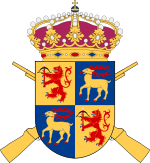 | |
| Active | 1626–1709, 1709–1927, 1994–1997 |
| Country |
|
| Allegiance | Swedish Armed Forces |
| Branch | Swedish Army |
| Type | Infantry regiment |
| Size | Regiment |
| Part of |
2nd Military District (1833–1893) 2nd Army Division (1893–1901) II Army Division (1902–1927) Southern Military Area (1990–1997) |
| Garrison/HQ | Kalmar |
| Colors | Red and yellow |
| March |
"Kaiser-Friedrich-Marsch" (–1927) "Kalmarbrigaden" (Badman)[1] (1994–1997) |
| Battle honours | Varberg (1565), Narva (1581), Warszawa (1656), Tåget över Bält (1658), Kliszow (1702), Helsingborg (1710), Svensksund (1790) |
| Insignia | |
| Cap badge |
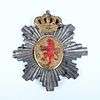 |
The Kalmar Regiment (Swedish: Kalmar regemente), designations I 20, I 21 and Fo 18, was a Swedish Army infantry regiment that traced its origins back to the 16th century. It was merged with another unit to form a new regiment in 1928. It was later reraised and disbanded again in 1997. The regiment's soldiers were originally recruited from Kalmar County, and it was later garrisoned there.
History
The regiment has its origins in fänikor (companies) raised in Kalmar County in the 16th century. In 1616, these units—along with fänikor from the nearby Kronoberg County—were organised by Gustav II Adolf into Smålands storregemente, of which twelve of the total 24 companies were recruited in Kalmar County. Smålands storregemente consisted of three field regiments, of which Kalmar Regiment was one. Sometime around 1623, the grand regiment was permanently split into three smaller regiments, of which Kalmar Regiment was one.
Kalmar Regiment was one of the original 20 Swedish infantry regiments mentioned in the Swedish constitution of 1634. The regiment's first commander was Patrick Ruthwen. The regiment was allotted in 1686. The regiment was given the designation I 20 (20th Infantry Regiment) in a general order in 1816. The designation was changed to I 21 in 1892.
The regiment was garrisoned in Eksjö from 1906, before it was merged with Jönköping Regiment to form Jönköping-Kalmar Regiment in 1927. Kalmar Regiment was reorganised in 1994 as a local defence area with the designation Fo 18, although disbanded again just three years later in 1997.
Heraldry and traditions
The regiment has carried a number of colours over the years. On 24 June 1866, major general P E Lovén presented a new colour to the two battalions of the regiment, which then replaced the previous colours. The colours were used until the disbandment of the regiment, and were carried by Jönköping-Kalmar Regiment (I 12) from 1928 to 1954. When Kalmar Regiment was re-raised in the form of a defense area staff, the regiment was assigned a new colour. The new Kalmar Regiment adopted the same colour as the Kalmar Regiment which was disbanded in 1927. However, the regiment did not inherit the 1866 colour, but was presented with a new colour model 1994.[2] The colour was presented in Kalmar by the Chief of the Army, lieutenant general Åke Sagrén on 10 October 1992. It was used as regimental colour by Fo 18 until 15 December 1997.[3] The colour is drawn by Bengt Olof Kälde and embroidered by machine and hand in insertion technique by Gunilla Hjort. Blazon: "On red cloth in the centre on a circular yellow shield the provincial badge of Smaland; a red lion rampant, armed blue, in the forepaws a red crossbow with a white arrow and black bow, string and trigger. On a yellow border at the upper side of the colour, battle honours (Varberg 1565, Narva 1581, Warszawa 1656, Tåget över Bält 1658, Kliszow 1702, Helsingborg 1710, Svensksund 1790) in red."[3]
In connection with the disbandment of Kalmar Regiment through the Defence Act of 1996, its traditions was continued from 1 December 1998 onwards by Kalmar Group (Kalmargruppen).[2] From 1 July 2013, the Kalmar Battalion, within Kalmar and Kronoberg Group (Kalmar- och Kronobergsgruppen), is the traditional keeper of Kalmar Regiment.[4]
The original regiment had "Kalmar regementets marsch" (Meissner) and "Kaiser Friedrich-Marsch" (Friedemann) as their marchers. The new Kalmar Regiment adopted the march "Kalmarbrigaden" (Badman), originally awarded to the Kalmar Brigade (IB 42).[2]
In 1997, the Kalmar regementes minnesmedalj ("Kalmar Regiment Commemorative Medal") in silver (KalmregMSM) was established. The ribbon is split in red, yellow, red, yellow and red.[5]
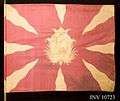 1766 colour of Kalmar Regiment.
1766 colour of Kalmar Regiment.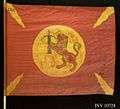 1849 colour of 1st Battalion, Kalmar Regiment.
1849 colour of 1st Battalion, Kalmar Regiment.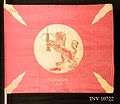 1849 colour of 2nd Battalion, Kalmar Regiment.
1849 colour of 2nd Battalion, Kalmar Regiment. Kalmar Regiment Commemorative Medal in silver.
Kalmar Regiment Commemorative Medal in silver.
Campaigns
- The Northern Seven Years' War (1563–1570)[Note1 1]
- The Livonian War (1570–1582)[Note1 1]
- The Polish War (1600–1629)
- The Thirty Years' War (1630–1648)
- The Northern Wars (1655–1661)
- The Scanian War (1674–1679)
- The Great Northern War (1700–1721)
- The Hats' Russian War (1741–1743)
- The Seven Years' War (1757–1762)
- The Gustav III's Russian War (1788–1790)
- The First War against Napoleon (1805–1810)
- The Finnish War (1808–1809)
- The Second War against Napoleon (1813–1814)
- The Campaign against Norway (1814)
Organisation
|
|
Commanding officers
Regimental commander active at the regiment during the years 1623–1927 and 1994–1997.[6]
- 1623–16??: Patrick Ruthven
- 1630–1639: David Drummund
- 1639–1645: Thure Bremer
- 1645–1656: Alexander Irving
- 1656–1662: Gustaf Kruse
- 1662–1674: Barthold
- 1674–1677: Henrik Wulfvenkhu
- 1677–1686: Erik Soop
- 1686–1698: Hans v. Dellinghausen
- 1698–1699: Magnus Stenbock
- 1699–1700: Nils Djurklou
- 1700–1701: N Djurklow
- 1701–1709: G Ranck †
- 1709–1716: C Björnberg
- 1716–1730: S Sture (POW), †
- 1730–1733: G Zülich
- 1733–1734: F C Marschalk
- 1734–1736: L von Muners
- 1736–1739: C de Frumerie
- 1739–1740: A J Giertta
- 1740–1747: L Fahlström
- 1747–1757: C G von Roxendorff
- 1757–1757: N Djurlkou
- 1757–1770: E G Lillienberg
- 1770–1772: E Armfelt (never took position)
- 1772–1778: A W von Baltzar
- 1778–1779: F Posse
- 1779–1795: A D Schönström
- 1795–1802: C Mörner
- 1802–1804: A L von Frisendorff
- 1804–1816: J H Tavast
- 1812–1813: M F F Björnstjerna (acting)
- 1813–1814: C M Klingström (acting)
- 1816–1826: E G Ulfsparre
- 1826–1832: C M Klingström
- 1832–1847: C J Hederstierna
- 1847–1853: G E A Taube
- 1853–1859: G G H Stierngranat
- 1859–1865: F M L Dandenell
- 1865–1877: E O Weidenhielm
- 1871–1877: P S W Björkman (acting)
- 1877–1888: P S W Björkman
- 1888–1894: O G Nordenskjöld
- 1894–1895: H F Gyllenram
- 1895–1902: Fredrik Kugelberg
- 1902–1910: Carl Gustaf Knut Eklundh
- 1910–1914: Carl Adam Constans Stålhammar
- 1914–1926: Sam Gustaf Laurentius Myhrman
- 1926–1927: Natanael Wikander
- 1990–1994: Birger Jägtoft
- 1994–1995: Birger Jägtoft
- 1995–1997: Dan Albin Snell
Name, designation and garrison
| Name | Translation | From | To | |
|---|---|---|---|---|
| Kalmar regemente | Kalmar Regiment | 1623 | – | 1927-12-31 |
| Kalmar regemente | Kalmar Regiment | 1994-07-01 | – | 1997-12-15 |
| Designation | From | To | |
|---|---|---|---|
| I 20 | 1816 | – | 1892-12-31 |
| I 21 | 1893-01-01 | – | 1927-12-31 |
| Fo 18 | 1994-07-01 | – | 1997-12-15 |
| Training ground or garrison town | From | To | |
|---|---|---|---|
| Staby ängar | 1685 | – | 1783 |
| Mariannelund | 1783 | – | 1796-03-14 |
| Hultsfred | 1796-03-14 | – | 1906-11-01 |
| Kulltorp | 1844-06-03 | – | 1884-01-26 |
| Eksjö (G) | 1906-11-01 | – | 1927-12-31 |
| Eksjö (G) | 1994-07-01 | – | 1997-12-15 |
See also
Footnotes
References
Notes
- ↑ Sandberg 2007, p. 203
- 1 2 3 Braunstein 2003, pp. 93-95
- 1 2 Braunstein 2004, pp. 82-83
- ↑ "Försvarets traditioner i framtiden – Bilaga 3" (PDF) (in Swedish). Statens försvarshistoriska museer/Försvarets traditionsnämnd. 2012-07-01. p. 1. Retrieved 12 June 2018.
- ↑ "KalmregMSM". www.medalj.nu (in Swedish). Retrieved 12 June 2018.
- ↑ Kjellander 2003, pp. 273-274
- Braunstein, Christian (2003). Sveriges arméförband under 1900-talet. Skrift / Statens försvarshistoriska museer, 1101-7023 ; 5 (in Swedish). Stockholm: Statens försvarshistoriska museer. ISBN 91-971584-4-5. LIBRIS 8902928.
- Braunstein, Christian (2004). Svenska försvarsmaktens fälttecken efter millennieskiftet [The flags and standards of the Swedish armed forces after the turn of the millennium] (PDF). Skrift / Statens försvarshistoriska museer, 1101-7023 ; 7 [dvs 8] (in Swedish). Stockholm: Statens försvarshistoriska museer. ISBN 91-971584-7-X. LIBRIS 9815350.
- Kjellander, Rune (2003). Sveriges regementschefer 1700-2000: chefsbiografier och förbandsöversikter (in Swedish). Stockholm: Probus. ISBN 91-87184-74-5. LIBRIS 8981272.
- Sandberg, Bo (2007). Försvarets marscher och signaler förr och nu: marscher antagna av svenska militära förband, skolor och staber samt igenkännings-, tjänstgörings- och exercissignaler (in Swedish) (New ed.). Stockholm: Militärmusiksamfundet med Svenskt marscharkiv. ISBN 978-91-631-8699-8. LIBRIS 10413065.
Further reading
| Wikimedia Commons has media related to Kalmar Regiment. |
- Frode, Rune; Balk, Steve (1984). Kungl. Kalmar regemente på Hultsfreds slätt 1685-1918. Skrifter / Hultsfreds kommun, 0282-891X ; 6 (in Swedish). Hultsfred: Hultsfreds kommun. ISBN 91-7810-072-0. LIBRIS 7666643.
- Kongl. Calmare regemente och Eksjö garnison: en jubileumsskrift till Norra Smålands regementes kamratförenings 50-årsjubileum (in Swedish). Eksjö: Kamratfören. 1995. LIBRIS 2058274.
- Mankell, Julius (1866). Anteckningar rörande svenska regementernas historia (2nd ed.). Örebro: Lindh. pp. 354–361. LIBRIS 1549756.
- Rudelius, Folke (1940). Kalmar regementes mötesplatser: några anteckningar (in Swedish). Kalmar. LIBRIS 3202962.
- Rudelius, Folke (1952). Kalmar regementes personhistoria 1623-1927: biografiska anteckningar om officerare och likställda. D. 1, Officerare 1623-1799 och exspektanter 1723-1753 (in Swedish). [Åby]: [förf.] LIBRIS 1983213.
- Rudelius, Folke (1955). Kalmar regementes personhistoria 1623-1927: biografiska anteckningar om officerare och likställda. D. 2, Officerare 1800-1927 : reservofficerare och officerare i reserven 1892-1927 : civilmilitär personal 1623-1927 (in Swedish). Norrköping: [förf.] LIBRIS 1983214.